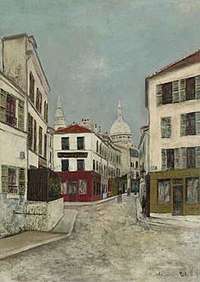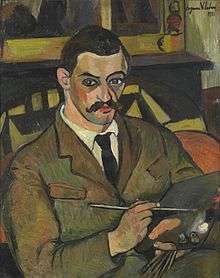Maurice Utrillo
Maurice Utrillo (French: [mɔʁis ytʁijo, moʁ-]), born Maurice Valadon (26 December 1883 – 5 November 1955), was a French painter who specialized in cityscapes. Born in the Montmartre quarter of Paris, France, Utrillo is one of the few famous painters of Montmartre who were born there.[1]
Maurice Utrillo | |
|---|---|
 La Rue Norvins à Montmartre, c. 1910 | |
| Born | Maurice Valadon 26 December 1883 Montmartre, Paris, France |
| Died | 5 November 1955 (aged 71) Dax, Aquitaine, France |
| Nationality | French |
| Education | Self-taught |
| Known for | Painting |
Biography

Utrillo was the son of the artist Suzanne Valadon (born Marie-Clémentine Valadon), who was then an eighteen-year-old artist's model. She never revealed who was the father of her child; speculation exists that he was the offspring from a liaison with an equally young amateur painter named Boissy, or with the well established painter, Pierre-Cécile Puvis de Chavannes, or even with Renoir.[2] (see below under Utrillo's Paternity). In 1891 a Spanish artist, Miguel Utrillo y Molins, signed a legal document acknowledging paternity, although the question remains as to whether he was in fact the child's father.[3]
Valadon, who became a model after a fall from a trapeze ended her chosen career as a circus acrobat,[4] found that posing for Berthe Morisot, Renoir, Henri de Toulouse-Lautrec, and others provided her with an opportunity to study their techniques. She taught herself to paint, and when Toulouse-Lautrec introduced her to Edgar Degas, he became her mentor. Eventually she became a peer of the artists she had posed for.
Meanwhile, her mother was left to raise the young Maurice, who soon showed a troubling inclination toward truancy and alcoholism.[5] When a mental illness took hold of the 21-year-old Utrillo in 1904, his mother encouraged him to take up painting. He soon showed real artistic talent. With no training beyond what his mother taught him, he drew and painted what he saw in Montmartre. After 1910 his work attracted critical attention, and by 1920 he was internationally acclaimed. In 1928, the French government awarded him the Cross of the Légion d'honneur.[6] Throughout his life, however, he was interned in mental asylums repeatedly.
.jpg)
Today, tourists to the area will find many of his paintings on post cards, one of which is his very popular 1936 painting entitled Montmartre Street Corner or Lapin Agile.
In middle age Utrillo became fervently religious and in 1935, at the age of fifty-two, he married Lucie Valore and moved to Le Vésinet, just outside Paris. By that time, he was too ill to work in the open air and painted landscapes viewed from windows, from post cards, and from memory.
Although his life also was plagued by alcoholism, he lived into his seventies. Maurice Utrillo died on 5 November 1955 in Hotel Splendid in Dax [7] of a lung disease, and was buried in the Cimetière Saint-Vincent in Montmartre.
Paternity
An apocryphal anecdote told by Diego Rivera concerning Utrillo's paternity is related in the unpublished memoirs of one of his American collectors, Ruth Bakwin:
"After Maurice was born to Suzanne Valadon, she went to Renoir, for whom she had modeled nine months previously. Renoir looked at the baby and said, 'He can't be mine, the color is terrible!' Next she went to Degas, for whom she had also modeled. He said, 'He can't be mine, the form is terrible!' At a cafe, Valadon saw an artist she knew named Miguel Utrillo, to whom she spilled her woes. The man told her to call the baby Utrillo: 'I would be glad to put my name to the work of either Renoir or Degas!'"[8]
2010 exhibitions and sale
In 2010, several retrospective exhibitions were staged, at Oglethorpe University Museum of Art[9] and in Montmartre (Paris) that culminated in an auction of 30 of Utrillo's works on 30 November 2010[10] from the collection of Paul Pétridès, Utrillo's art dealer, whose Galerie Pétridès also dealt with the likes of Jacques Thévenet. This follows the exhibition of Suzanne Valadon and Maurice Utrillo's works held in Paris in 2009.[10]
Notes
- "Maurice Utrillo | artnet". www.artnet.com. Retrieved 3 May 2016.
- Peter Schjeldahl (7 February 2012). "Renoir at The Frick: Go See "Dance at Bougival"". The New Yorker. Retrieved 13 September 2014.
- Warnod 1981, p.48.
- Warnod 1981, p.13.
- Warnod 1981, pp.57–59.
- Warnod 1981, p.85.
- "Desert Sun 5 November 1955 Edition 02 — California Digital Newspaper Collection". cdnc.ucr.edu. Retrieved 23 August 2018.
- 'Parting With the Family van Gogh' in the New York Times, 22 April 2006
- "Pastel exhibit, Utrillo oils create colorful contrast at Oglethorpe", Chris North, reporter newspapers.net, 3 June 2010, accessed 1 December 2010
- PAUL PÉTRIDÈS COLLECTION: 30 Works by Maurice Utrillo Archived 6 December 2010 at the Wayback Machine, accessed 1 December 2010 (Paul Pétridès (1901–93) was Utrillo's dealer from 1937, and the author of the catalogue raisonné of his work.)
References
- Jean Fabris, Claude Wiart, Alain Buquet, Jean-Pierre Thiollet, Jacques Birr, Catherine Banlin-Lacroix, Joseph Foret: Utrillo, sa vie, son oeuvre (Utrillo, his life, his works), Editions Frédéric Birr, Paris, 1982.
- Longstreet, Stephen and Ethel (1958), Man of Montmartre, A Novel based on the Life of Maurice Utrillo, New York, Funk & Wagnalls, 403 pages.
- Warnod, Jeanine (1981). Suzanne Valadon. New York: Crown. ISBN 0-517-54499-7